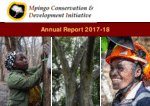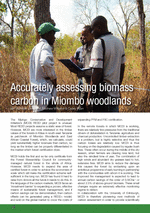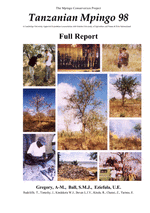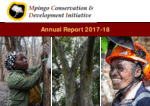Our Impacts
Community Benefits
By showing communities how to unlock the value in local forests, we are creating opportunities for rural Tanzanians to leverage forest resources as assets to pursue their own development aspirations. This is real empowerment, and makes our approach unique compared to that of many other development NGOs. Communities themselves decide how to spend their forest revenues, whilst we support this process by nurturing effective and transparent governance systems that promote community-wide engagement and benefit distribution. As a result, local income from timber has been used to improve social services and fund development projects with broad-based benefits for entire communities, such as:

- 259 expectant mothers subsidised with money towards maternal care
- 20 mattresses and 40 blankets for the village health center
- Health insurance for 20 elderly people in the village
- A house for the village nurse and A midwife's house

- One primary, A nursery school school and two classrooms
- 323 uniforms for primary school students and 92 school desks
- Free school meals provided in one school
- A furnished house for a primary school teacher, fitted with solar panels
- A ward secondary school laboratory

- A village guesthouse
- Two marketplaces, one equipped with solar panels
- 10 million Tanzanian Shillings contributed towards a ward police post
- Two village offices
- A house for a Village Executive Officer

- 13 water wells
- 53 households provided with maize in times of hardship
Forest Conservation
Tanzania has 48.1 million hectares of forests, nearly half of which occur on land that is managed by rural communities. Tanzania's forests are ecologically significant. They play a vital role in mitigating climate change, due to the estimated 9.03 trillion tonnes of carbon they store and sequester.
Forests in Tanzania provide many other ecosystem services. The role of forests in stabilizing soils and protecting water catchments is particularly important in southern Tanzania, where infrastructure and social development lag behind other parts of the country and so more than half of the rural poor depend on subsistence agriculture to support their livelihoods.
They are also important preserves for biodiversity. They harbour Africa's largest number of mammals (364 species), second largest number of plants (10,000 species), third largest number of birds (1,035 species) and fourth largest number of reptiles and amphibians (368 species), between 9% and 11% of which occur nowhere else in the world. The coastal forests of south-eastern Tanzania are particularly diverse, hosting some of the highest densities of endemic species globally.
Despite the local and global importance of Tanzania's forests, these are being lost at the fifth-fastest rate in the world. By empowering rural Tanzanians to unlock the value in their natural forests through sustainable timber harvesting, we are providing them with tangible incentives to protect these important habitats - for their own benefit, for future generations and for the world. By 2017, we had enabled 40 rural communities in southern Tanzania to own and sustainably manage over 410,000 hectares of natural forests by setting up locally-controlled forest reserves on their land.
These forests are comprised of a patchwork of miombo woodlands interspersed with some of the last remaining pockets of East African coastal forests, a rapidly disappearing biodiversity hotspot of global importance. Our work is therefore making a significant contribution towards the conservation of these irreplaceable wildlife habitats.
This work was formally commended in 2016 when our CEO won two prestigious international awards: the Whitley Fund for Nature Award for International Nature Conservation and the National Geographic Society Buffett Award for Leadership in African Conservation.



Annual Reports

Combining REDD, PFM and FSC-certification in South-Eastern
Integrating Reduced Emissions from Deforestation and Forest Degradation (REDD) with Participatory Forest Management (PFM) is key to ensuring benefits from REDD reach forest-adjacent communities, and

Timber Stocks Assessment Kilwa District 2004.pdfWide-Scale Timber Stocks
Rapid Stocks Assessment of Mpingo & Other Timber Species for Kilwa District

Drivers of Deforestation and Forest Degradation in Kilwa District.pdfDrivers of Deforestation in Kilwa District1.2 M
Drivers of Deforestation and Forest Degradation in Kilwa District

Quantifying carbon stocks for REDD implementation in Kilwa District.
This document describes and details the work completed to date by MCDI and the University of Edinburgh (UoE) on generating baseline carbon stock estimates against which future changes in carbon stoc

Markets for 5 timber species found in community forests in Tanzania
International market potential for certified timber of five locally prized woods commonly found in south-east Tanzania

Stocks and exploitation of East African blackwood: a flagship species for Tanzania’s Miombo woodlands? Oryx 38(3): 266-272
Stocks and exploitation of East African blackwood: a flagship species for Tanzania’s Miombo woodlands?

Participatory Forest Resources Assessment: Experiences from Kilwa. Arc Journal 21: 21-23
Conducting a Participatory Forest Resources Assessment (PFRA) is a necessary step in introducing participatory forest management (PFM) to an area of forest

Oryx Conservation News April 2010.
First commercial timber harvest from a community-managed forest in Tanzania

Biodiversity conservation and certified community forests ETFRN 51
A major motivation of the founders of the Forest Stewardship Council (FSC) was to develop a market mechanism that would support community forestry in the tropics.

Assessing biomass carbon in miombo Arc Journal 27
The Mpingo Conservation and Development Initiative’s (MCDI) REDD pilot project is unusual. Most REDD projects assume a static area of forest.

1998 Mpingo Ecology & Exploitation Expedition Report.
Mpingo is the common (Swahili) name for Dalbergia melanoxylon. The tree is used to make high quality woodwind instruments such as clarinets and oboes, and it is used in traditional African carvings,

1999 Community Attitudes Expedition Report.pdf1.5 M
This study provides information on local uses of and attitudes towards the African Blackwood tree (scientific name: Dalbergia melanoxylon, local name: mpingo) in Tanzania.

2000 Large-scale Mpingo Survey Report.pdf1.3 M
Misafara ya nyuma ya wanafunzi ya mradi wa mpingo mwaka 1996 na 1998 ilitafiti maeneo yenye wingi wa mpingo kusini mashariki mwa Tanzania. Matokeo ya utafiti huu ulipelekea ugumu wa kutumia taarifa

2001 Carvings Market Investigation Report.pdf1.0 M
Effective management and conservation of the Mpingo or East African Blackwood (Dalbergia melanoxylon) in Tanzania relies upon an understanding of carvings supply and demand drivers
Publication

MCDI Annual Report 2018-19
Deforestation is responsible for 10% of global carbon emissions and sustainable forest management has become a priority strategy to mitigate climate change.

MCDI Annual Report 2017-18
Deforestation is responsible for 10% of global carbon emissions and sustainable forest management has become a priority strategy to mitigate climate change

MCDI Strategy 2018-231.9 M
The role played by the Government of Tanzania, and more specifically the work done by the Ministry of Tourism and Natural Resources of the Government of Tanzania, for continuously improving
